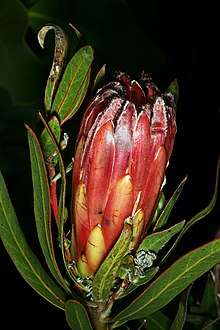Protea burchellii
Protea burchellii, also known as Burchell's sugarbush,[1][4][5][6] is a flowering shrub in the genus Protea which is endemic to South Africa.[1][5]
| Protea burchellii | |
|---|---|
 | |
| Protea burchellii, Proteaceae, flowerhead; Caledon, South Africa. | |
| Scientific classification | |
| Kingdom: | Plantae |
| Clade: | Tracheophytes |
| Clade: | Angiosperms |
| Clade: | Eudicots |
| Order: | Proteales |
| Family: | Proteaceae |
| Genus: | Protea |
| Species: | P. burchellii |
| Binomial name | |
| Protea burchellii | |
| Synonyms[1][3] | |
| |
The shrub is known by the vernacular name of blinksuikerbos in the Afrikaans language.[6]
Taxonomy
Protea burchellii was described by Otto Stapf in the Flora Capensis in 1912.[2][7]
The name commemorates the collector of the type specimens, William Burchell.[7]
Description
The plant takes the form of a spreading, evergreen shrub with erect-growing limbs. It grows up to three metres in height,[5][6] and one or two metres wide. The branches all arise from a single central stem.[6] The length of a generation in this species is estimated to be around 20 years.[1]
The linear to narrowly oblong leaves are olive-green in colour, and are spotted with tiny black points.[6]
It blooms in the Winter,[4][6] specifically primarily from June to August in most of its native South Africa,[5] but sometimes into Spring on the Cape Peninsula.[4] The flowers are clustered together in a flower head, a special type of inflorescence, which is surrounded by bracts. In this species this structure will grow up to 10 cm in length by 7 cm wide.[6] The bracts are often pink, but forms with white-coloured bracts exist, as do red-[4] and yellow-coloured forms. The colour range has been described as "cream-coloured to deep carmine".[6]
Distribution
This species is endemic to the southern and southwestern Cape Region of South Africa,[1][3] where it is only found in the Western Cape province.[1][4] The range extends from the Hottentots Holland Mountains to the Olifants River Mountains, Cape Peninsula (historically) to the flatland plains of Hopefield Flats and Witzenbergvlakte, and Piketberg and the upper part of the Breede River Valley.[5] It grows around the Paarl Rock and near the town of Mamre.[4]
Ecology
Wildfire will destroy the adult plants, but the seeds can survive such an event. The plant is monoecious with both sexes in each flower. Pollination occurs through the action of birds. The seed is stored in a cap which is retained in the dried inflorescence, which itself remains attached to the plant after senescence. The seeds are eventually dispersed by means of the wind. The plant grows in a variety of habitats but prefers to grow in more fertile soils. It occurs at altitudes of 100 to 850 metres.[5]
Conservation
In 1998 Protea burchellii was considered locally common and not threatened, but by this time it was already considered extinct on the Cape Peninsula.[5] Nonetheless it has been photographed blooming on the Lion's Head on the Cape.[4]
The species was classified as "vulnerable" on the Redlist of South African Plants by the South African National Biodiversity Institute (SANBI) in 2008.[1]
It grows in areas generally unsuitable for normal cultivation, and most habitat loss was thought to be fairly recent in 2008. Nonetheless, SANBI estimated that the 'historical' population had been reduced at least 30% based on a habitat loss of some 40%, primarily to agricultural development. This was especially caused by the recent success of the vineyards and olive orchards. SANBI estimated that with the continuing viability of these farms a further reduction of the population by 30% is likely by the year 2028.[1]
References
- Rebelo, A.G.; Mtshali, H.; von Staden, L. (21 March 2008). "Burchell's Sugarbush". Red List of South African Plants. version 2020.1. South African National Biodiversity Institute. Retrieved 9 August 2020.
- "Protea burchellii". International Plant Names Index. The Royal Botanic Gardens, Kew, Harvard University Herbaria & Libraries and Australian National Botanic Gardens. Retrieved 10 August 2020.
- "Protea burchellii Stapf". Plants of the World Online. Kew Science. 2017. Retrieved 10 August 2020.
- "Protea burchellii (Burchell's sugarbush)". Biodiversity Explorer. Iziko - Museums of South Africa. Retrieved 10 August 2020.
- "Spoon-bract Sugarbushes - Proteas". Protea Atlas Project Website. 11 March 1998. Retrieved 10 August 2020.
- McQuillan, Monique (June 2008). "Protea burchellii Stapf". PlantZAfrica. South African National Biodiversity Institute. Retrieved 11 August 2020.
- Stapf, Otto (January 1912). "CXVII. Proteaceæ". In Thiselton-Dyer, William Turner (ed.). Flora Capensis; being a systematic description of the plants of the Cape Colony, Caffraria & Port Natal. 5. 1. London: Lovell Reeve & Co. p. 603, 604. doi:10.5962/bhl.title.821.